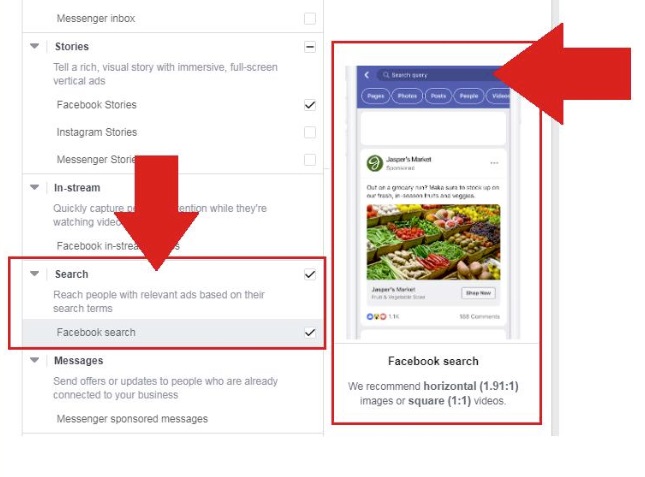Last December, TechCrunch reported that Facebook was re-launching its search ads after a five year absence. And this week, access to Facebook’s new search ad option appears to have been significantly expanded, with a range of Facebook advertisers reported that ‘Search’ is now an option within their Ad Placements tools.

As you can see in this example, which was shared by digital marketing consultant Steven Johns, search is now showing for more businesses in their ad placement options, while there’s also a basic example of how the new search ads look and work. When someone searches for a related term on Facebook, you can target that query, and have your ad shown in the results, similar to Google search ads.
As noted, Facebook originally launched search ads back in 2012, but abandoned them shortly after. This re-launched version is different to that initial offering, but focuses on the same functionality – in TechCrunch’s reportlast year, it noted that
“Advertisers will be able to extend their existing News Feed ads to the new “Search” placement through the Facebook Ads Manager, similar to how they’d pick Facebook Audience Network or Instagram. No video ads will be allowed, and search ads won’t appear on desktop. Marketplace search ads will appear on iOS and Android, while Facebook search ads are only testing on Android. For now, advertisers won’t pick specific keywords to advertise against, and instead may appear in search terms related to auto or retail topics.”
Facebook would appear to have evolved its search ad options from this, but the basic functionality remains the same.
How effective search placements will be will obviously be relative to the product/service you’re offering, and the specifics of your ad listing.
It’s also important to consider what users are searching for on the platform. Back in 2016, Facebook said that it was facilitating over 2 billion searches per day, a significant volume to consider, but we haven’t seen an update on that stat since, and with social media usage behaviors changing, and Facebook searches, you would assume, being less about specific products and services than the same on Google, the opportunities are more limited.
That doesn’t mean they won’t be effective, but there are some key considerations to keep in mind around the potential of Facebook search ad placements, and whether they might work for your business.
It’s not clear how much Facebook has expanded its search ad placements as yet (we’ve asked and will update if we get more info), but it’s another option to consider in your marketing strategy, in order to maximize the reach and resonance of your Facebook campaigns.
Get ready for good news Instagram fans.
As per social media code hacker Jane Manchun Wong:
One of the most requested features, Instagram is looking to add a new way to search through posted videos, enabling you to find specific moments.
Of course, most platforms already provide this functionality – as does Instagram itself on IGTV videos – but this new tool will make it easier to locate key points within uploaded content. It may not seem like a big deal, considering Instagram videos can only be 60 seconds long, but it will be a helpful addition, that’ll likely see significant use. If it’s actually rolled out, of course.
Instagram has kept a tight leash on content controls and options – you can only view one Instagram post at a time, for example (as opposed to swiping through each post from a profile), while you can’t include any links in your captions. As the platform expands, it’s looking to add in additional functionality to cater to user demand.
There’s no word from Instagram as to when, or if, this will be released, but given it’s now in the back-end, it’s likely close to seeing a proper roll out.
As you’re no doubt aware, Facebook Stories aren’t as popular as Instagram Stories, the most successful version of the format which Facebook copied from Snapchat (at least in western markets). But, even so, Facebook itself remains convinced that Stories is the format of the future, including on their main platform.
At their F8 developer conference earlier this year, several Facebook executives, including Mark Zuckerberg, noted that the Stories format is on track to overtake the News Feed as the most popular social sharing option, and that that will happen sometime this year.
Given that Instagram Stories is now at 400 million users, and WhatsApp ‘Status’ is up to 450 million, the growth of the option is clearly evident – but Facebook Stories, at 150 million daily actives, is still lagging behind.
But that slower rate of growth doesn’t appear to have dampened any enthusiasm for the potential of Facebook Stories in Menlo Park, with The Social Network releasing a new blog post promoting the potential of the format for businesses.

As noted by Facebook:
“The rise of stories is clear: people want fast, immersive and fun ways to share photos, videos and text with their friends and family – and stories offer just that. People use stories to share and discover content they’re interested in for movements as big as Pride and moments as small as the coffee they’re drinking. We designed stories on our platforms to fulfill people’s need to interact and share in engaging and playful ways on the vertical screen.”
I did laugh a little at the ‘we designed’ note – though probably not as funny to those at Snap Inc.
In the post, Facebook outlines the potential of Stories for brands, and their capacity to help marketers connect with their audiences, noting that a third of the most viewed stories on Instagram are from businesses.
But ads in Stories are where Facebook suggests there’s the most brand potential.
“Businesses are already seeing results using ads in Instagram Stories. For example, Tropicana ran video ads in Instagram Stories for its summertime product promotion campaign, achieving an 18-point lift in ad recall and 15-point lift in purchase intent among males. OpenTable used ads in Instagram Stories to drive online restaurant reservations, resulting in a 33% lower cost per reservation compared to other ad formats. And Overstock ran video ads in Instagram Stories to acquire new customers and increase sales, and generated an 18% higher return on ad spend and a 20% decrease in cost per acquisition.”
Right now, however, you can’t run ads on Facebo
Knowing how to optimize your social sites for local searches isn’t just important for your business.
Knowing how to optimize your social sites for local searches isn’t just important for your business — it’s becoming critical for survival.
Consumers are increasingly likely to have one foot out the door and one hand on their smartphones right at the very moment that they’re most inclined to buy. Whether they’re looking for a gadget in the local electronics store or buying a pair of shoes, consumers don’t stop and research a purchase first anymore. Instead, 77% of them actually do their research while standing inside the store!
These days, 80% of location-based mobile searches turn into a purchase. When you consider the fact that 72% of searchers end up making their purchases in a store within just a 5-mile radius of their search location, you can start to appreciate the importance of showing up in local SERPs.
Google’s main goal is to give people what they want as fast as possible — and what they want is some place close to their location to do business. Almost all the clicks – an amazing 92% — go to the sites that appear on the first page of any given search. Your goal is to get your business on that top page. It’s the only way you’re going to catch consumers when they’re in that micro-moment that determines where they’re going to buy.
How does social media tie into local search marketing
Social media has become integral to American culture. Fully 88% of U.S. adults have at least one social media account. Social is where people go to talk, laugh, argue, look for advice, and — ultimately — decide what to buy. Social media helps your brand engage with the local community. In turn, that helps generate more relevant content and unique posts — giving you a stronger online presence and organically driving your listing up in any given local SERP.
So how do you do you make it all happen? We can show you.
How Facebook Contributes To Search
Starting with Facebook is a good idea. Despite the bad press the platform has had lately, it still reigns supreme among social sites. It’s also shown itself to be highly favorable to business accounts. Facebook is the “go-to” site for consumers every time they are looking for information on a product or service.
Whether your Facebook page has been sitting around for a while or you’re just finally getting started on it, it’s time to take a few minutes to make some changes.
4 Needed Changes
- Update your URL. When you first registered your business for Facebook, you were given a URL that looks like a random string of numbers, letters, and symbols. As long as you have garnered more than 25 “likes” on your page, you aren’t stuck with it. Change it to something that reflects your business. Facebook calls it a “vanity” URL, but it gives you the opportunity for something like “www.facebook.com/MySpecialBrand” — which is a lot more eye-catching and useful for search.
- Add keywords to your brand’s category. Facebook markets dynamic ads to users based on various categories which accrue as they perform searches. You want to capitalize on that for local search by setting multiple relevant categories for your business. For example, “nail salon” and “waxing” would be good if you run a salon that does both.
- Add in your address. Go to the “Edit Page” button and click “Update Info.” In the About box, you’ll find “Basic Information.” Click that so you can add a description of your brand and make sure you get your name, phone number, and location — including the street and city — in there.
- Complete the About page. An empty space here is merely wasted. You have plenty of room for your brand’s website, email, mission statement, Twitter ID, Youtube channel, Pinterest board and a list of products. This is where a lot of your prospects automatically come looking for information. Don’t disappoint them.
If you’re still uncomfortable or nervous making all these changes — relax. You can go back and edit whenever necessary. Nothing you do has to stay that way forever.
“Local Business” Page
There is one Facebook feature you do need to consider: when you create a business page, you have the option to select either a “Company, Organization or Institution” page or a “Local Business” page. What’s the difference? Frankly, most of the features are the same – although you can’t add a mission statement to a local business page.
The big difference is that a local business page signal to viewers that you are a physical place they can visit – and you’re encouraging them to do so. A “company” page works better for brands with multiple locations or companies that deal through distributors or do an online-only business. If you have the wrong type of page now for your purposes, don’t fret – you can easily change it.
How Twitter Contributes To Search
Twitter is, in essence, a microblogging site. Over 500 million Tweets get sent out every single day — many of them to and by different brands. Some brands, like Netflix and Wendy’s, have even managed to cultivate a pretty dedicated group of followers through a combo of good information and disarming humor.
No matter what your style, however, it’s a great place to go when you want to promote a product or connect with your fan base. Piggybacking on trending Tweets can get you much-needed publicity and help boost your local search rankings.
When optimizing your Twitter account, you need to understand how Google uses it. Instead of pulling up the metadata on your profile, Google pulls a recent Tweet along with your name, profile, and follower count. Sometimes your bio will also appear. That makes it fairly easy to optimize:
- Make sure that your name and username reflect your business. Your username has to be unique — no other user can have it. Your name can be whatever you choose. If you can’t get MySpecialBrand@MySpecialBrand because “@MySpecialBrand” is taken, try for something close, like “MySpecialBrand@Brand” instead.
- Fill out your bio. The major challenge here is that you only have 160 characters to do it. Make it work for you. Get what you want people to know the most in there.
- Complete your location. This is critical to local search.
In this case, it’s important not to get stuck on any particular wording. Because of the way Google interacts with Twitter, you want to go back and tweak your bio to reflect your current marketing goals whenever necessary.
How Instagram Contributes To Search
You can’t afford to overlook Instagram these days, either. It’s quicker than Twitter and rich with visuals, which makes it ideal for brains that rely on lightning-fast internet connections – particularly Millennials. In addition, it’s loaded with shoppers. About 70% Instagram’s users are consumers looking for updates from their favorite brands on everything from the latest delectable dishes to next season’s styles.
Optimizing on Instagram for local search takes a little more work, simply because you don’t get a lot of links. However, you do get a section of Instagram that was designed just for business with all sorts of tools at your disposal that will help you measure your success. Start by:
- Choose a relevant username. You want to get as close to your brand name as possible — and consider adding in a location if you can do it easily. For example, “MySpecialBrand” works, but so does “MySpecialBrand_SoCal” if you happen to be in Southern California. That’s a tag that could help you in local searches.
- Fill out your bio. Again, brevity is key — you only get 150 characters. Make every character count. If you haven’t gotten your location in yet, do it here. For example, “Southern California’s SpecialBrand” would be good.
- Use Instagram’s geo-tagging feature and tell Instagram to publish it. That will help you show up in local SERPs.
- Make your brand relatable by giving it a voice — yours. Go to Instagram’s Stories and tell people why you do what you do.
Once again, it’s important to occasionally review everything. Set a goal to revamp everything at the start of every year, at least — or more often, if your industry tends to evolve quickly.
The Final Step
There’s one last rule you have to follow in order to be successful at social optimization: posting. You absolutely cannot rest on your accomplishments here. Social is all about timeliness — if you want to show up in SERPs, you have to post regularly and often. Otherwise, even your best efforts will fade out of the picture.
Learn the latest trends, insights and best practices from the brightest minds in media and technology. Sign up for SMW Insider to watch full-length sessions from official Social Media Week conferences live and on-demand.
Post By : Kelly Shelton
Content From : socialmediaweeks




